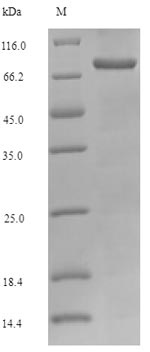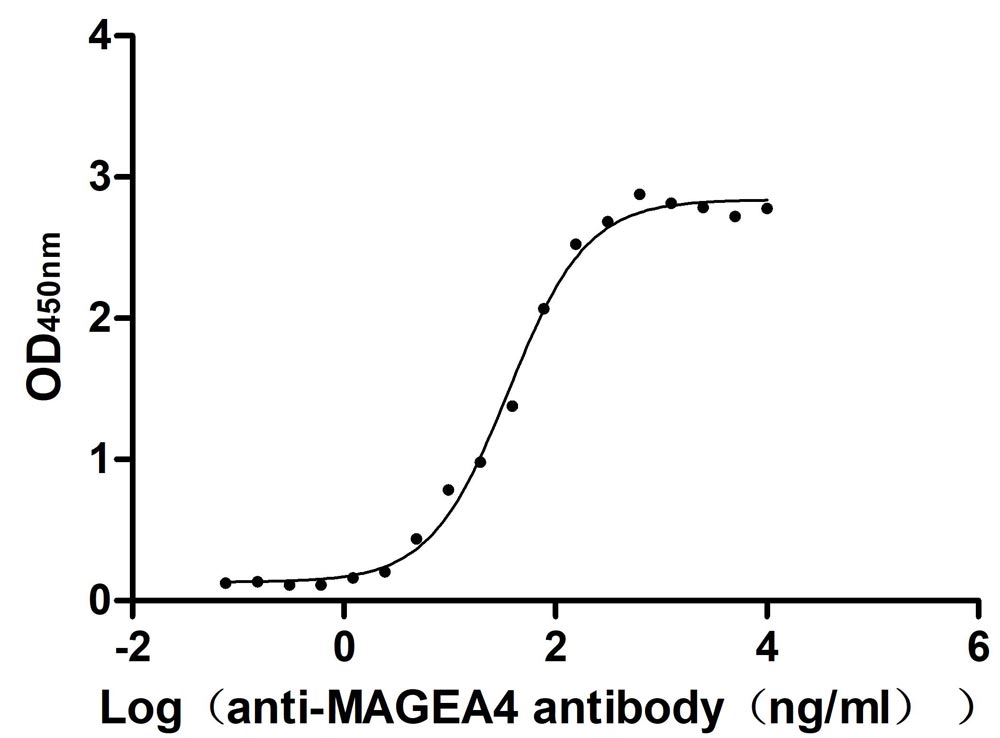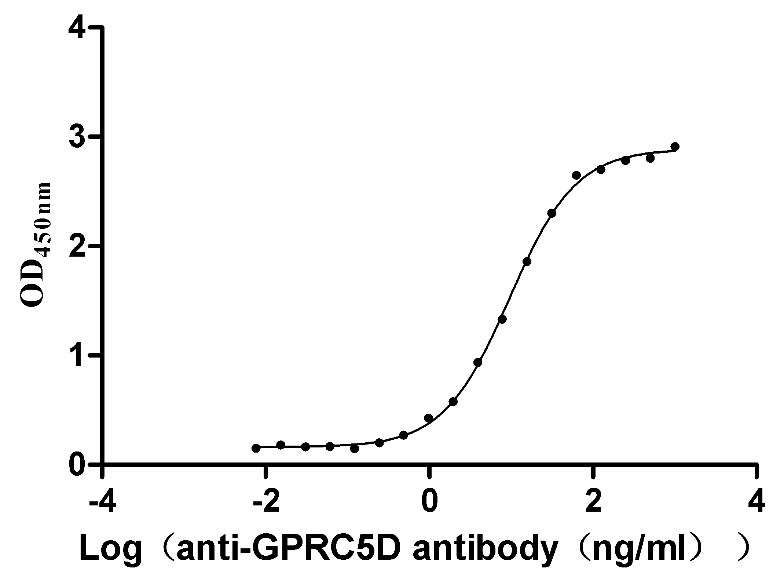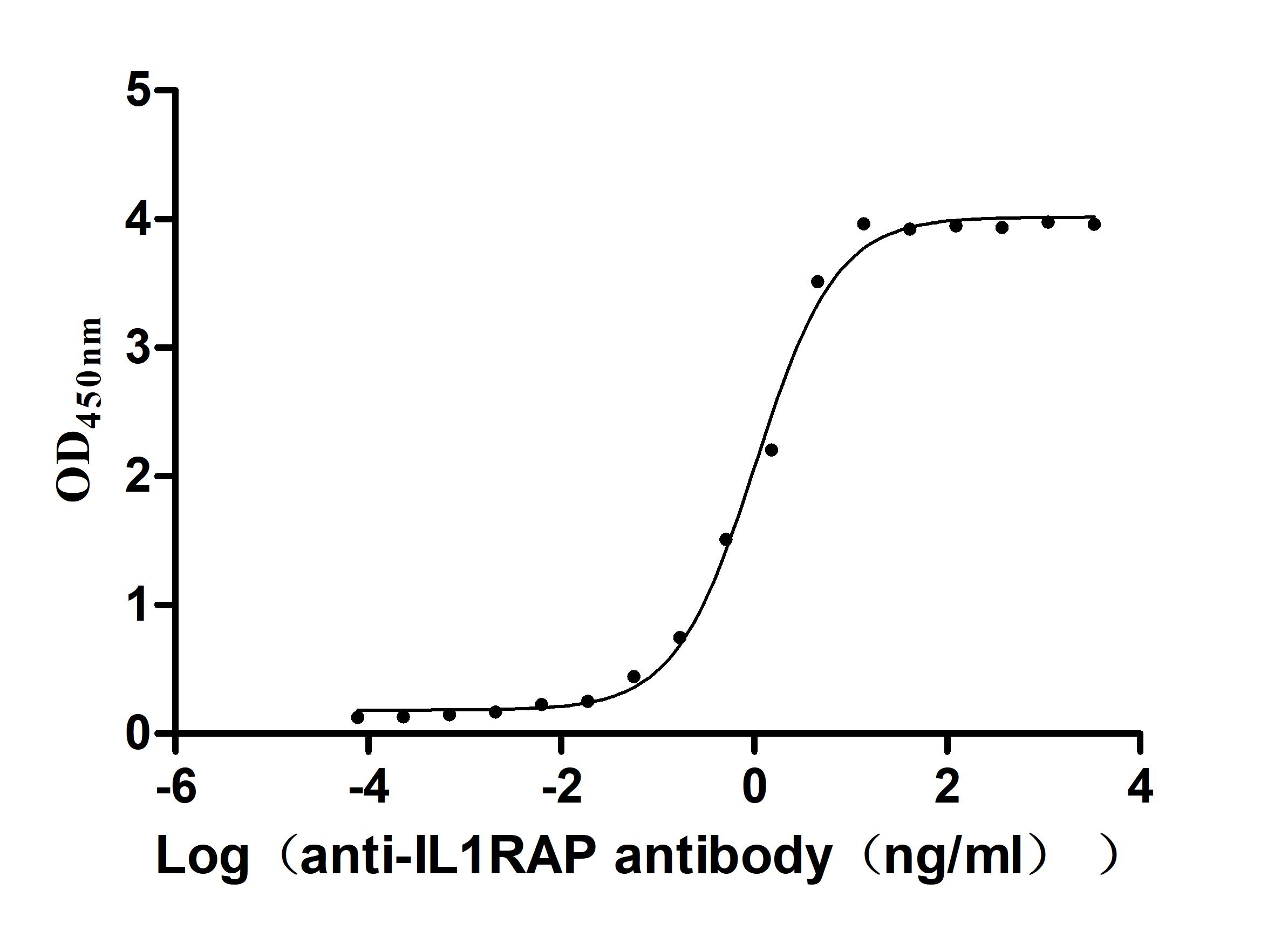Recombinant Mouse Kelch-like ECH-associated protein 1 (Keap1)
-
货号:CSB-EP012147MO
-
规格:¥1836
-
图片:
-
其他:
产品详情
-
纯度:Greater than 90% as determined by SDS-PAGE.
-
基因名:
-
Uniprot No.:
-
别名:Keap1; Inrf2; Kiaa0132Kelch-like ECH-associated protein 1; Cytosolic inhibitor of Nrf2; INrf2
-
种属:Mus musculus (Mouse)
-
蛋白长度:Full Length
-
来源:E.coli
-
分子量:85.6kDa
-
表达区域:1-624aa
-
氨基酸序列MQPEPKLSGAPRSSQFLPLWSKCPEGAGDAVMYASTECKAEVTPSQDGNRTFSYTLEDHTKQAFGVMNELRLSQQLCDVTLQVKYEDIPAAQFMAHKVVLASSSPVFKAMFTNGLREQGMEVVSIEGIHPKVMERLIEFAYTASISVGEKCVLHVMNGAVMYQIDSVVRACSDFLVQQLDPSNAIGIANFAEQIGCTELHQRAREYIYMHFGEVAKQEEFFNLSHCQLATLISRDDLNVRCESEVFHACIDWVKYDCPQRRFYVQALLRAVRCHALTPRFLQTQLQKCEILQADARCKDYLVQIFQELTLHKPTQAVPCRAPKVGRLIYTAGGYFRQSLSYLEAYNPSNGSWLRLADLQVPRSGLAGCVVGGLLYAVGGRNNSPDGNTDSSALDCYNPMTNQWSPCASMSVPRNRIGVGVIDGHIYAVGGSHGCIHHSSVERYEPERDEWHLVAPMLTRRIGVGVAVLNRLLYAVGGFDGTNRLNSAECYYPERNEWRMITPMNTIRSGAGVCVLHNCIYAAGGYDGQDQLNSVERYDVETETWTFVAPMRHHRSALGITVHQGKIYVLGGYDGHTFLDSVECYDPDSDTWSEVTRMTSGRSGVGVAVTMEPCRKQIDQQNCTC
Note: The complete sequence including tag sequence, target protein sequence and linker sequence could be provided upon request. -
蛋白标签:N-terminal 6xHis-SUMO-tagged
-
产品提供形式:Liquid or Lyophilized powder
Note: We will preferentially ship the format that we have in stock, however, if you have any special requirement for the format, please remark your requirement when placing the order, we will prepare according to your demand. -
缓冲液:Tris-based buffer,50% glycerol
-
储存条件:Store at -20°C/-80°C upon receipt, aliquoting is necessary for mutiple use. Avoid repeated freeze-thaw cycles.
-
保质期:The shelf life is related to many factors, storage state, buffer ingredients, storage temperature and the stability of the protein itself.
Generally, the shelf life of liquid form is 6 months at -20°C/-80°C. The shelf life of lyophilized form is 12 months at -20°C/-80°C. -
货期:Basically, we can dispatch the products out in 1-3 working days after receiving your orders. Delivery time may differ from different purchasing way or location, please kindly consult your local distributors for specific delivery time.Note: All of our proteins are default shipped with normal blue ice packs, if you request to ship with dry ice, please communicate with us in advance and extra fees will be charged.
-
注意事项:Repeated freezing and thawing is not recommended. Store working aliquots at 4°C for up to one week.
-
Datasheet & COA:Please contact us to get it.
相关产品
靶点详情
-
功能:Substrate-specific adapter of a BCR (BTB-CUL3-RBX1) E3 ubiquitin ligase complex that regulates the response to oxidative stress by targeting NFE2L2/NRF2 for ubiquitination. KEAP1 acts as a key sensor of oxidative and electrophilic stress: in normal conditions, the BCR(KEAP1) complex mediates ubiquitination and degradation of NFE2L2/NRF2, a transcription factor regulating expression of many cytoprotective genes. In response to oxidative stress, different electrophile metabolites trigger non-enzymatic covalent modifications of highly reactive cyst...显示更多
-
基因功能参考文献:
- Nrf2/Keap1 system regulates VSMC apoptosis during neointimal formation, thereby inhibiting neointimal hyperplasia after a vascular injury. PMID: 27198574
- Renal tubular deletion of Keap1 promotes nephrogenic diabetes insipidus features, confirming that Nrf2 activation in developing tubular cells causes a water reabsorption defect. PMID: 28233855
- By inhibiting binding of Keap1 to Nrf2. PMID: 30021365
- these studies are the first to demonstrate that Brain ischemic preconditioning protects the blood-brain barrier against ischemic injury by generation of endogenous electrophiles and activation of the Nrf2 pathway through inhibition of Keap1- and GSK3beta-dependent Nrf2 degradation. PMID: 29775963
- these results suggested that trehalose can function as a novel activator of the p62-Keap1/Nrf2 pathway, in addition to inducing autophagy. Therefore, trehalose may be useful to treat many chronic diseases involving oxidative stress and dysfunction of autophagy. PMID: 29241092
- While injury tended to suppress these genes in wild-type mice, the suppression was attenuated or reversed in Keap1 hypomorphs, suggesting that protection in these mice was mediated by increased Nrf2 transcriptional activity. PMID: 27804998
- These findings suggest that Keap1-Nrf2 system plays a key role in depression and that dietary intake of sulforaphane-rich food during juvenile stages and adolescence can confer stress resilience in adulthood. PMID: 27470577
- these results indicated that inactivation of KEAP1 protein by epigallocatechin gallate may mediate epigallocatechin gallate function in activating NRF2 PMID: 28457936
- the incidence, multiplicity and burden of Cutaneous squamous cell carcinomas that form in Keap1(flox/flox)/Nrf2(-/-) mice are much greater than in their Keap1(flox/flox)/Nrf2(+/+) counterparts, establishing Nrf2 activation as the protection mediator. PMID: 27216826
- The p62-keap1-Nrf2 antioxidant pathway was primarily activated in the early stage of APAP hepatotoxicity. PMID: 29331651
- Keap1 deletion in renal tubular cells results in an abnormal kidney development consistent with hydronephrosis. PMID: 27484495
- serine 351 phosphorylation of p62 did not enhance its binding to Keap1 or stabilise the nuclear factor erythroid 2-related factor 2 (Nrf2) transcription factor in this neuronal context. Nrf2 protein levels were markedly decreased despite transcriptional activation of the Nrf2 gene PMID: 28055010
- These results suggest that the Keap1/Nrf2 axis plays a critical role in NFATc1 expression and osteoclastogenic progression. PMID: 28515152
- Results show that Keap1 deficiency in long-term hematopoietic stem cells increases the number of multipotent progenitor cells in steady-state hematopoiesis, and impairs their hematopoietic regeneration capacity . PMID: 28674188
- During cellular stress or electrolytic imbalance, cysteine residue modification in Keap1 induces Nrf2 release from the Nrf2-Keap1 complex, which stabilizes Nrf2 and causes its nuclear translocation. PMID: 28045693
- This study found that under oxidative stress induced by experimental periodontitis, the Nrf2/antioxidant defense pathway was activated and could be visualized from the luciferase activity in the in Keap1-dependent oxidative stress detector-luciferase mice model. PMID: 27854327
- Caffeic acid induces Nrf2 activation by decreasing the expression of its inhibitor protein Keap1 and blocking the binding of Nrf2 with Keap1. PMID: 26721592
- Hepatocyte-specific deletion of Keap1 triggering constitutive Nrf2 activation shifts hepatic metabolism towards increased lipid catabolism, reduced liponeogenesis and activation of the pentose phosphate pathway. PMID: 26698665
- findings reveal that Keap1 regulates cell migration by affecting the subcellular localization and activity of cortactin independently of its role in oxidant stress responses. PMID: 26602019
- chronic hyperglycemic conditions, Keap1 inhibition increased Nrf2 nuclear translocation, increased antioxidant gene expression, and reduced ROS production to normoglycemic levels. PMID: 26647385
- conclusion, increased Keap1/Nrf2 signaling in the liver is accompanied by repressed gluconeogenesis and lipogenesis that can, at least partially, explain the ameliorated diabetic phenotype in the Keap1-hypo mice. PMID: 26701603
- Keap1 utilizes multiple cysteine residues specifically and/or collaboratively as sensors for the detection of a wide range of environmental stresses. PMID: 26527616
- iron deficiency induced the nuclear translocation of Nrf2 via Keap1 degradation by autophagy and subsequently upregulated expression of HO-1. PMID: 25754743
- These results strongly suggest that p62 plays a crucial role in preventing fenofibrate-induced cell death. PMID: 26282199
- high-fat diet altered short-term glucose homeostasis to a greater degree in Keap-KD mice compared to C57BL/6 mice PMID: 23507082
- Keap1 knockdown caused severe disruption in both the redox cycle and the cell cycle of replicating hepatocytes. PMID: 25483186
- data confirm a role for GNOM in endoplasmic reticulum (ER)-Golgi trafficking and reveal that a GNL1/GNOM-mediated early secretory pathway selectively regulates PIN1 basal polarity establishment in a manner essential for normal plant development PMID: 24997191
- Results implicate p62-dependent autophagic degradation of Keap1 by palmitate as a mechanism contributing to hepatocyte lipoapoptosis. PMID: 24769730
- the high degree of selectivity of CDDO-me for the Nrf2:Keap1 signalling pathway. PMID: 24859727
- Data indicate feedback activation of the kelch-like ECH-associated protein 1 (Keap1)-NF-E2-Related Factor 2 (Nrf2) pathway when the proteasome is impaired. PMID: 25049227
- forced expression of WT mKeap1 restored the ability of oxaliplatin to activate the transcription factor. Cys(151) in Keap1 was required for the response stimulated by oxaliplatin. PMID: 24556415
- Nrf2 activation by Keap1 knockdown attenuates glomerulosclerosis. These results indicate that the Nrf2-Keap1 system is a promising drug target for the treatment of chronic kidney diseases. PMID: 24523358
- Keap1-Nrf2 complex prevents oxidative injury in ischemia/reperfusion-stressed orthotopic liver transplantation through Keap1 signaling, which negatively regulates Nrf2 pathway. PMID: 23867319
- The bone marrow cells of Keap1-deficient mice showed enhanced granulocyte-monocyte differentiation and lower erythroid and lymphoid, suggesting granulocyte-monocyte lineage priming in Keap1-null HSCs. PMID: 24580727
- Caloric restriction induced induction of fatty acid oxidation gene expression was augmented with Keap1 knockdown, which was associated with differential expression of several miRNAs implicated in fatty acid oxidation and lipid accumulation. PMID: 23884569
- Phosphorylation of p62 activates the Keap1-Nrf2 pathway during selective autophagy. PMID: 24011591
- Silencing of Keap1 in macrophages boosts induced transcription of Il-6 via NF-kappaB activation. PMID: 23906629
- the Keap1/Nrf2 axis regulates RANKL-dependent osteoclastogenesis through modulation of intracellular ROS signaling via expression of cytoprotective enzymes. PMID: 23801334
- Genetic activation of Nrf2 signaling by Keap1 gene hypomorphic knockdown (Keap1flox/-) markedly suppresses the onset of diabetes. PMID: 23716596
- This study assigns a novel positive role of Keap1 in upregulating p62-mediated autophagic clearance of ubiquitin aggregates. PMID: 20495340
- R-alpha-lipoic acid exerts a neuroprotective effect against oxidative stress in retinal neurons in vitro and in vivo by inducing HO-1 through Keap1/Nrf2 signaling. PMID: 23295186
- the Keap1-C151-dependent mechanism of Nrf2 activation is protective, while p62-mediated activation or somatic mutations leading to persistent or prolonged Nrf2 activation comprise the side of Nrf2 that is expected to promote tumor growth and survival. PMID: 23589329
- The Keap1-Nrf2 system regulates an important defense mechanism against upper aerodigestive tract carcinogenesis. PMID: 23250896
- study discovered that the Nrf2/Keap1 pathway detects loss of loricrin and directly upregulates the expression of genes involved in the compensatory response, thus ensuring postnatal survival PMID: 23237955
- HFD-induced obesity and lipid accumulation in white adipose tissue was decreased in Keap1-KD mice PMID: 22936178
- The autophagy pathway maintains the integrity of the Keap1-Nrf2 system for the normal liver function by governing the Keap1 turnover PMID: 22872865
- Morphological changes of the esophageal epithelium are associated with dynamic changes in gene expression. Nrf2/Keap1 pathway activity is required for maturation of mouse esophageal epithelium. PMID: 22567161
- Activation of endogenous intracellular levels of Nrf2 by siRNA knockdown of Keap1 is sufficient to protect in models of oxidative stress and Parkinson's disease. PMID: 22342405
- The p62-Nrf2-Nqo1 cascade functions to assure mammalian longevity by stabilizing mitochondrial integrity. PMID: 22222206
- Induction of antioxidative stress protein keap1 after cerebral ischemia may play an important endogenous neuroprotective response. PMID: 21075092
收起更多
-
亚细胞定位:Cytoplasm. Nucleus.
-
数据库链接:
KEGG: mmu:50868
STRING: 10090.ENSMUSP00000062467
UniGene: Mm.248266





















